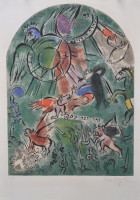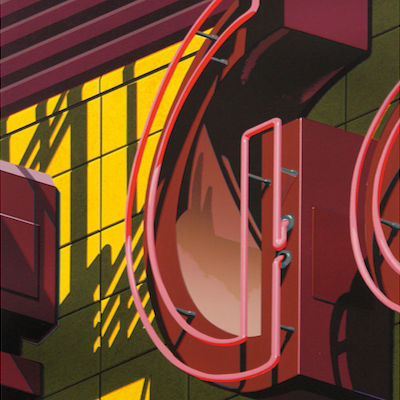



Details
Artist
Styles
Annotated by the artist " Pour Henry Deschamp - tres amicalement" - not numbered - The work was published in the book Paul Delvaux: Graphic Work by Mira Jacob. // La Voyante by Paul Delvaux, created in 1974, is a captivating lithograph that evokes a surreal and introspective mood. The artwork features a nude woman standing on a small red table in an architectural setting that blends elements of the interior and exterior. Behind her is a large structure with arched windows, evoking a temple or house, bathed in moonlight, which enhances the ethereal quality of the scene. The woman gazes directly at the viewer, her expression calm and enigmatic, as if she possesses hidden knowledge or a prophetic vision. Delvaux’s use of muted colors and shadow creates a haunting, dreamlike atmosphere, characteristic of his exploration of surrealism and themes of mystery, solitude, and femininity. This piece invites viewers to ponder the relationship between the seen and the unseen, as well as the boundary between reality and the subconscious.
La voyante, 1974
form
Medium
Size
100 x 68.5 cm
- Inches
- Centimeters
Edition
Price
Details
Artist
Styles
Annotated by the artist " Pour Henry Deschamp - tres amicalement" - not numbered - The work was published in the book Paul Delvaux: Graphic Work by Mira Jacob. // La Voyante by Paul Delvaux, created in 1974, is a captivating lithograph that evokes a surreal and introspective mood. The artwork features a nude woman standing on a small red table in an architectural setting that blends elements of the interior and exterior. Behind her is a large structure with arched windows, evoking a temple or house, bathed in moonlight, which enhances the ethereal quality of the scene. The woman gazes directly at the viewer, her expression calm and enigmatic, as if she possesses hidden knowledge or a prophetic vision. Delvaux’s use of muted colors and shadow creates a haunting, dreamlike atmosphere, characteristic of his exploration of surrealism and themes of mystery, solitude, and femininity. This piece invites viewers to ponder the relationship between the seen and the unseen, as well as the boundary between reality and the subconscious.
- Recently Added
- Price (low-high )
- Price (high-low )
- Year (low-high )
- Year (high-low )
Paul Delvaux
Construction D'un Temple En Ruine De La Déesse Vanadé Paris, 1975
Limited Edition Print
Etching
Currently Not Available
What is Hyper-realism?
Hyperrealism is a genre of sculpture and painting that closely resembles high-resolution photographs. It is an evolution of Photorealism and is often applied to an independent art style or movement that became prominent in Europe and the United States in the early 2000s. Hyperrealist artists focus on extreme detail and precision, creating works that are often indistinguishable from real-life images.





















